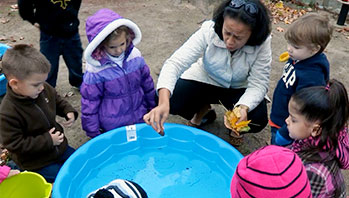- camera or video camera
- science notebooks
- absorb
- drip
- drop
- flow
MA Standards:
Language/L.PK.MA.6: Use words and phrases acquired through conversations, listening to books read aloud, activities, and play.
MA Draft STE Standards:
Earth and Space Sciences/Earth’s Systems/ESS2.A: Observe, investigate, and classify the non-living materials, natural and human made, in their environment.
Head Start Outcomes:
Logic and Reasoning/Reasoning and Problem Solving: Classifies, compares, and contrasts objects, events, and experiences.
Science Knowledge/Scientific Skills and Method: Collects, describes, and records information through discussions, drawings, maps, and charts.
Science Knowledge/Conceptual Knowledge of Natural and Physical Worlds: Observes, describes, and discusses properties of materials and transformation of substances.
PreK Learning Guidelines:
English Language Arts/Language 2: Participate actively in discussions, listen to the ideas of others, and ask and answer relevant questions.
Science and Technology/Inquiry Skills 4: Record observations and share ideas through simple forms of representation such as drawings.
Science and Technology/Physical Sciences 19: Explore, describe, and compare the properties of liquids and solids found in children's daily environment.
Explore Together (outdoors): Water Drops

© Commonwealth of Massachusetts, Department of Early Education and Care. All rights reserved.
STEM Key Concepts: Water can flow quickly or slowly; Water drops stick together; Water behaves differently on different surfaces
ELA Focus Skills: Listening and Speaking, Vocabulary
Educator Prep: This activity is best done after a rain shower. However, if that is not possible, pour water over or down a surface (for example, down a playground slide or gutter pipe) to create a situation where water is dripping off a surface.
Safety Tip: Be aware of and check areas for poison ivy, poison sumac, nettles and bushes with thorns before taking children outside.
Take children outdoors. Encourage them to look for places where water is flowing down or dripping off surfaces.
Once children have found dripping water, have them freely explore the drops. Take photos or a video to record children’s observations. Encourage children to explore the drops with their hands. Ask questions such as,
- What happens to the water drop when you touch it? Encourage children to note in detail what happens to the drop—how it changes in size, shape, etc.
- What happens to your skin when you touch the water drops? Draw children’s attention to the fact that their skin does not absorb water.
Then allow time for children to make “raindrops” themselves. Have children dip their hands in water and watch how the water drips down from their fingers. Have them flick water with their hands at smooth surfaces, like a window, railing, or slide. Say, Watch how the “raindrops” flow down the different surfaces. What do you see? Guide children to make observations. Say, Look at that raindrop flowing really fast! That little one is flowing slowly. What do you think you could do to make it flow faster?
Reflect and Share
Once children are inside have them share what they observed while exploring the water drops. Encourage them to use the photographs or video while sharing their ideas. Have children draw a picture in their science notebooks to show one thing they learned while exploring water drops. Help them dictate or write a caption.
